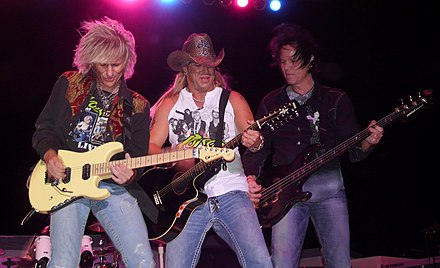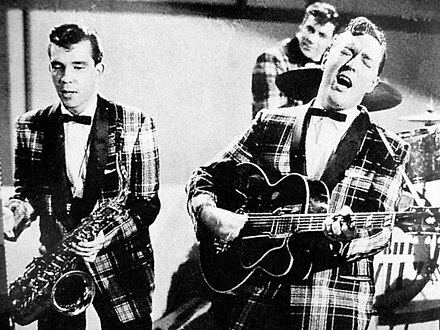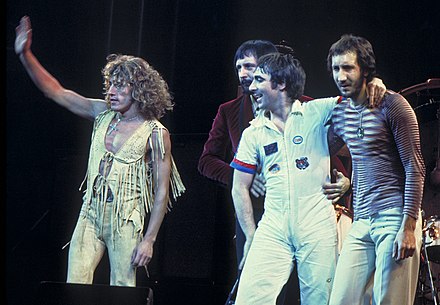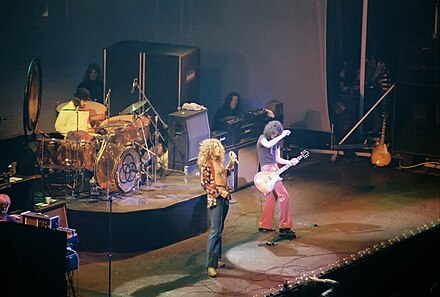Portal:Rock music
The Rock Music Portal
Rock is a broad genre of popular music that originated as "rock and roll" in the United States in the late 1940s and early 1950s, developing into a range of different styles from the mid-1960s, particularly in the United States and the United Kingdom. It has its roots in 1940s and 1950s rock and roll, a style that drew directly from the blues and rhythm and blues genres of African-American music and from country music. Rock also drew strongly from genres such as electric blues and folk, and incorporated influences from jazz and other musical styles. For instrumentation, rock has centered on the electric guitar, usually as part of a rock group with electric bass guitar, drums, and one or more singers. Usually, rock is song-based music with a 4
4 time signature using a verse–chorus form, but the genre has become extremely diverse. Like pop music, lyrics often stress romantic love but also address a wide variety of other themes that are frequently social or political. Rock was the most popular genre of music in the U.S. and much of the Western world from the 1950s to the 2010s.
Rock musicians in the mid-1960s began to advance the album ahead of the single as the dominant form of recorded music expression and consumption, with the Beatles at the forefront of this development. Their contributions lent the genre a cultural legitimacy in the mainstream and initiated a rock-informed album era in the music industry for the next several decades. By the late 1960s "classic rock" period, a number of distinct rock music subgenres had emerged, including hybrids like blues rock, folk rock, country rock, southern rock, raga rock, and jazz rock, which contributed to the development of psychedelic rock, influenced by the countercultural psychedelic and hippie scene. New genres that emerged included progressive rock with extended artistic elements, glam rock, highlighting showmanship and visual style. In the second half of the 1970s, punk rock reacted by producing stripped-down, energetic social and political critiques. Punk was an influence in the 1980s on new wave, post-punk and eventually alternative rock.
From the 1990s, alternative rock began to dominate rock music and break into the mainstream in the form of grunge, Britpop, and indie rock. Further fusion subgenres have since emerged, including pop-punk, electronic rock, rap rock, and rap metal. Some movements were conscious attempts to revisit rock's history, including the garage rock/post-punk revival in the 2000s. Since the 2010s, rock has lost its position as the pre-eminent popular music genre in world culture, but remains commercially successful. The increased influence of hip-hop and electronic dance music can be seen in rock music, notably in the techno-pop scene of the early 2010s and the pop-punk-hip-hop revival of the 2020s. (Full article...)
General images -
Selected article
In 1965, the band came together as a folk rock trio known as the Raggamuffins, before expanding to the quintet that was later rechristened the Music Machine. The group was known for their style of dress, clothing themselves in all-black attire. In 1966, the Music Machine was signed to Original Sound, and released its first single "Talk Talk" in the latter half of the year, with it reaching the Top 20 of the Billboard Hot 100. Their debut album (Turn On) The Music Machine and the moderate hit "The People in Me" followed. The band's original lineup fragmented in late 1967 after managerial and financial disputes. Bonniwell reassembled the group under the name The Bonniwell Music Machine. In 1968, a second album, The Bonniwell Music Machine appeared, but the group disbanded in early 1969. (Full article...)
Selected biography
Ochs performed at many political events during the 1960s counterculture era, including anti-Vietnam War and civil rights rallies, student events, and organized labor events over the course of his career, in addition to many concert appearances at such venues as New York City's Town Hall and Carnegie Hall. Politically, Ochs described himself as a "left social democrat" who became an "early revolutionary" after the protests at the 1968 Democratic National Convention in Chicago led to a police riot, which had a profound effect on his state of mind.
After years of prolific writing in the 1960s, Ochs's mental stability declined in the 1970s. He had a number of mental health problems, including depression, bipolar disorder and alcoholism, and died by suicide in 1976.
Ochs's influences included Woody Guthrie, Pete Seeger, Buddy Holly, Elvis Presley, Bob Gibson, Faron Young, and Merle Haggard. His best-known songs include "I Ain't Marching Anymore", "When I'm Gone", "Changes", "Crucifixion", "Draft Dodger Rag", "Love Me, I'm a Liberal", "Outside of a Small Circle of Friends", "Power and the Glory", "There but for Fortune", "The War Is Over", and "No More Songs". (Full article...)
Selected album
The Basement Tapes is the sixteenth album by the American singer-songwriter Bob Dylan and his second with the Band. It was released on June 26, 1975, by Columbia Records. Two-thirds of the album's 24 tracks feature Dylan on lead vocals backed by the Band, and were recorded in 1967, eight years before the album's release, in the lapse between the release of Blonde on Blonde and the subsequent recording and release of John Wesley Harding, during sessions that began at Dylan's house in Woodstock, New York, then moved to the basement of Big Pink. While most of these had appeared on bootleg albums, The Basement Tapes marked their first official release. The remaining eight songs, all previously unavailable, feature the Band without Dylan and were recorded between 1967 and 1975.
During his 1965–1966 world tour, Dylan was backed by the Hawks, a five-member rock group who would later become famous as the Band. After Dylan was injured in a motorcycle accident in July 1966, four members of the Hawks came to Dylan's home in the Woodstock area to collaborate with him on music and film projects. While Dylan was out of the public's eye during an extended period of recovery in 1967, he and the members of the Hawks recorded more than 100 tracks together, incorporating original compositions, contemporary covers, and traditional material. Dylan's new style of writing moved away from the urban sensibility and extended narratives that had characterized his most recent albums, Highway 61 Revisited and Blonde on Blonde, toward songs that were more intimate and which drew on many styles of traditional American music. While some of the basement songs are humorous, others dwell on nothingness, betrayal and a quest for salvation. In general, they possess a rootsy quality anticipating the Americana genre. For some critics, the songs on The Basement Tapes, which circulated widely in unofficial form, mounted a major stylistic challenge to rock music in the late sixties.
When Columbia Records prepared the album for official release in 1975, eight songs recorded solely by the Band—in various locations between 1967 and 1975—were added to 16 songs taped by Dylan and the Band in 1967. Overdubs were added in 1975 to songs from both categories. The Basement Tapes was critically acclaimed upon release, reaching number seven on the Billboard Top LPs & Tape album chart. Subsequently, the format of the 1975 album has led critics to question the omission of some of Dylan's best-known 1967 compositions and the inclusion of material by the Band that was not recorded in Woodstock. (Full article...)
Selected song
"Tomorrow Never Knows" is a song by the English rock band the Beatles, written primarily by John Lennon and credited to Lennon–McCartney. It was released in August 1966 as the final track on their album Revolver, although it was the first song recorded for the LP. The song marked a radical departure for the Beatles, as the band fully embraced the potential of the recording studio without consideration for reproducing the results in concert.
When writing the song, Lennon drew inspiration from his experiences with the hallucinogenic drug LSD and from the 1964 book The Psychedelic Experience: A Manual Based on the Tibetan Book of the Dead by Timothy Leary, Richard Alpert and Ralph Metzner. The Beatles' recording employed musical elements foreign to pop music, including musique concrète, avant-garde composition and electro-acoustic sound manipulation. It features an Indian-inspired modal backing of tambura and sitar drone and bass guitar, with minimal harmonic deviation from a single chord, underpinned by a constant but non-standard drum pattern; added to this, tape loops prepared by the band were overdubbed "live" onto the rhythm track. Part of Lennon's vocal was fed through a Leslie speaker cabinet, normally used for a Hammond organ. The song's backwards guitar parts and effects marked the first use of reversed sounds in a pop recording, although the Beatles' 1966 B-side "Rain", which they recorded soon afterwards using the same technique, was issued over two months before the release of Revolver.
"Tomorrow Never Knows" was an early and highly influential recording in the psychedelic and electronic music genres, particularly for its pioneering use of sampling, tape manipulation and other production techniques. It also introduced lyrical themes that espoused mind expansion, anti-materialism and Eastern spirituality into popular music. On release, the song was the source of confusion and ridicule by many fans and journalists; it has since received praise as an effective representation of a psychedelic experience. Pitchfork placed the track at number 19 on its list of "The 200 Greatest Songs of the 1960s", and Rolling Stone ranked it at number 18 on the magazine's list of the 100 greatest Beatles songs. (Full article...)
Selected picture

Elvis Presley meeting with US President Richard Nixon. On December 21, 1970.
Did you know (auto-generated)

- ... that the heavy metal band Cradle of Filth released a T-shirt that was so offensive that several people were arrested for wearing it?
- ... that Shin Hae-chul, who previously made hard rock and heavy metal albums, was inspired by big band music when he made The Songs for the One?
- ... that before charting on the UK Albums Chart with Are We There Yet?, the indie rock musician James Marriott had made a career of mocking other YouTubers' music?
- ... that the heavy metal musician Leah has sometimes been called "the metal Enya"?
- ... that heavy metal band Judas Priest took their name from Bob Dylan's song "The Ballad of Frankie Lee and Judas Priest"?
- ... that Desulfovibrio vulgaris can remove toxic heavy metals from the environment?
Selected genre
The new wave of British heavy metal (commonly abbreviated as NWOBHM) was a nationwide musical movement that started in England in the mid-1970s and achieved international attention by the early 1980s. Editor Alan Lewis coined the term for an article by Geoff Barton in a May 1979 issue of the British music newspaper Sounds to describe the emergence of new heavy metal bands in the mid to late 1970s, during the period of punk rock's decline and the dominance of new wave music. (Full article...)
Selected audio
Related portals
WikiProjects
Things you can do
Expand: College rock, Electronic rock, Pop rock
Clean Up: Instrumental rock, Rap rock, New wave, Industrial rock, Progressive metal, Southern rock, Folk rock, Funk rock, Space rock
Add Sources: Pagan rock
Join one of the many WikiProjects pertaining to Rock music.
News
No recent news
More articles -
Physical Graffiti is the sixth studio album by the English rock band Led Zeppelin. Released as a double album on 24 February 1975 in the United States and on 28 February 1975 in the United Kingdom, it was the group's first album to be released under their new label, Swan Song Records. The band wrote and recorded eight new songs for the album in early 1974 at Headley Grange, a country house in Hampshire, which gave them ample time to improvise arrangements and experiment with recording. The total playing time covered just under three sides of an LP, so they decided to expand it into a double album by including previously unreleased tracks from the sessions for the band's earlier albums Led Zeppelin III (1970), Led Zeppelin IV (1971) and Houses of the Holy (1973). The album covered a range of styles including hard rock, progressive rock, rock 'n' roll and folk. The album was then mixed over summer 1974 and planned for an end-of-year release; however, its release was delayed because the Peter Corriston-designed die-cut album cover proved difficult to manufacture.
Physical Graffiti was commercially and critically successful upon its release and debuted at number one on album charts in the UK and number three in the US. It was promoted by a successful US tour and a five-night residency at Earl's Court, London. The album has been reissued on CD several times, including an expansive 40th anniversary edition in 2015. Physical Graffiti was later certified 16× platinum in the United States by the Recording Industry Association of America (RIAA) in 2006, signifying shipments of over eight million copies in the US. (Full article...)More did you know...
- ... that David Bowie's first gig as lead singer was at the Green Man, Blackheath?
- ... that Carlton le Willows Academy alumni include cricketer Mark Footitt, Air Supply singer/guitarist Graham Russell, and balloonist Janet Folkes?
- ... that the video for Marilyn Manson's soft-rock ballad "Running to the Edge of the World" was widely condemned for its depiction of violence against women?
- ... that Susan Beschta was a punk rocker and federal judge?
.jpg/440px-Vintage_Eico_FM_Mono_Tuner,_Metal_Case,_8_Vacuum_Tubes,_Model_HFT-90,_Circa_1959_(12686012174).jpg)
- ... that the FM Non-Duplication Rule adopted by the FCC 59 years ago led to the creation of the album-oriented and classic rock radio formats?
- ... that The Elvis Dead, a retelling of Evil Dead II in the style of Elvis Presley, features songs such as "Standing in a State of Shock", "I've Been Possessed", and "Wrapped Up in Vines"?
Major topics
Subcategories
Associated Wikimedia
The following Wikimedia Foundation sister projects provide more on this subject:
-
Commons
Free media repository -
Wikibooks
Free textbooks and manuals -
Wikidata
Free knowledge base -
Wikinews
Free-content news -
Wikiquote
Collection of quotations -
Wikisource
Free-content library -
Wikiversity
Free learning tools -
Wikivoyage
Free travel guide -
Wiktionary
Dictionary and thesaurus


.JPG/440px-Little_Richard_1957_(cropped).JPG)



















.jpg/440px-20111015_174748_phil-ochs_(cropped).jpg)













